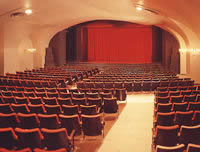The first thing noticeable about Hart House Theatre is that it’s hardly noticeable. Shakespeare’s (rebuilt) Globe, rising grandly on the banks of the Thames, it certainly is not. It is well earthed, below grade, and therefore hidden partially from view. Ensconced underneath Hart House, the theatre sits, providing the behemoth above with indispensable support. But while its exterior may be unprepossessing, the theatre’s physical position is nicely metaphoric of its founda-tional place in the history of English-speaking Canadian drama.
Belying its later importance, Hart House Theatre came about as an afterthought. The young Vincent Massey (BA 1910 UC), scion of Canada’s first family of farm machinery and the moving spirit behind the creation of Hart House, together with his wife, Alice, decided that the cavern beneath the quadrangle was the perfect fit for a theatre. With Hart House near completion the theatre was designed and built quickly to open in November 1919, the same month as the building itself.
Though physically part of the building, the theatre was not part of the Massey Foundation’s gift of Hart House to the university. Rather, it was administered independently by the Player’s Club and then until 1935 by the Board of Syndics with Massey as chairman. In 1945 the theatre was donated to the university; since 1986 it has been under the control of the Office of Space Management.
Productions were staged beginning in November 1919 and full seasons ensued. In short order, the small 500-seat space (since reduced to 454 seats) found itself at the forefront of amateur theatre in English-speaking Canada. Hart House Theatre played host to campus productions, the Canadian Little Theatre Movement, the Dominion Drama Festival and others. In 1966, the 20-year residency of U of T’s Graduate Centre for the Study of Drama began. Since the theatre’s inception, directors such as Edgar Stone, Robert Gill and Bertram Forsyth all integral to the development of U of T drama and the Canadian stage have guided students.
The “cast” of Hart House Theatre is immense: Dora Mavor Moore, Lloyd Bochner (BA 1947 UC), Johnny Wayne (BA 1940 UC), Frank Shuster (BA 1939 UC, LLD Hon. 1994), Kate Reid, Ted Follows, Rod Beattie, Charmion King (BA 1947 UC), R.H. Thomson (BSc 1969 Trin), Donald Sutherland (BA 1958 VIC, LLD Hon. 1998), Don Harron (BA 1948 VIC, DLitt Sac Hon. 1991), William Hutt (BA 1948 TRIN), Lorne Michaels (BA 1966 UC), Urjo Kareda (BA 1966 UC, MA 1967) and many others. All trod the boards in a myriad of productions, their words echoing off the thick walls.
Sutherland, as a young and greatly aspiring Maritimer, came to U of T in 1953 in order to become an actor at Hart House Theatre. “I came for that theatre. Expressly for that,” he recently wrote in a letter to longtime manager, Janet Bessey. Squirrelled away in her underground office, Bessey has worked at the theatre since 1968, as manager since 1977. Her love for the place is evident as she recounts the theatres storied history, including its recent travails. Funding, the eternal nemesis of small theatre, is at the root of the problem. However, in December it was announced happily that the theatre would be integrated into Hart Houses cultural programming. The theatre has set itself a five-year, six-million-dollar fundraising target in order to establish a permanent endowment. In the meantime, U of T will provide transitional funding.
The long history of Hart House Theatre; its sloped, gangway entrance, which gives the impression that it is about to swallow you whole; its submerged, intimate space; its substantial proscenium arch; and its old hemp ropes, rather than modern metal cables, hanging riotously above the stage all add up to a richness of experience rare in theatre anywhere. For more than 80 years, Hart House Theatre has been a place of lofty dreams, soaring imagination and artistic beauty. “It sings,” extols Sutherland. Clearly, it is a place that has proven itself well worthy of breaking a leg.
Recent Posts
U of T’s 197th Birthday Quiz
Test your knowledge of all things U of T in honour of the university’s 197th anniversary on March 15!
Are Cold Plunges Good for You?
Research suggests they are, in three ways
Work Has Changed. So Have the Qualities of Good Leadership
Rapid shifts in everything from technology to employee expectations are pressuring leaders to constantly adapt






